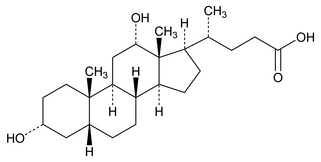Desoxycholic Acid
DEFINITION
Desoxycholic Acid contains NLT 98.0% and NMT 102.0% of C24H40O4, calculated on the dried basis.
IDENTIFICATION
• Add 2 drops of benzaldehyde and 3 drops of 75% sulfuric acid to about 10 mg of Desoxycholic Acid, heat at 50 for 5 min, and then add 10 mL of glacial acetic acid. A green color appears. (Cholic acid produces a brown color.)
for 5 min, and then add 10 mL of glacial acetic acid. A green color appears. (Cholic acid produces a brown color.)
ASSAY
• Procedure
Sample:
500 mg
Analysis:
Transfer the Sample into a 250-mL Erlenmeyer flask, and add 20 mL of water and 40 mL of alcohol. Cover the flask with a watch glass, heat the mixture gently on a steam bath until the Sample is dissolved, and allow the mixture to cool to room temperature. Add a few drops of phenolphthalein TS to the solution, and titrate with 0.1 N sodium hydroxide to a pink endpoint that persists for 15 s. Each mL of 0.1 N sodium hydroxide is equivalent to 39.26 mg of C24H40O4.
Acceptance criteria:
98.0%–102.0% on the dried basis
IMPURITIES
Inorganic Impurities
• Residue on Ignition  281
281 :
NMT 0.2%, using 1.0 g
:
NMT 0.2%, using 1.0 g
• Limit of Lead
[Note—Select reagents having as low a lead content as practicable, and store all solutions in high-density polyethylene containers. Rinse all plastic and glassware thoroughly with warm, 50% nitric acid followed by water. ]
Standard lead solution:
Prepare as directed under Heavy Metals  231
231 , Special Reagents.
, Special Reagents.
Standard solutions:
[Note—Prepare these solutions on the day of use. ] Transfer 10.0 and 50.0 mL of the Standard lead solution into two separate 100-mL volumetric flasks, add 10 mL of 3 N hydrochloric acid to each, and dilute with water to volume. The third standard, 10.0 µg/mL, is taken directly from the Standard lead solution.
Sample solution:
Transfer 10.0 g of Desoxycholic Acid, weighed to the nearest 0.1 mg, into an evaporating dish. Add 5 mL of 25% sulfuric acid (made by adding 25 mL of sulfuric acid to 75 mL of water), and distribute the 25% sulfuric acid solution uniformly. Within a hood, place the dish on a steam bath to evaporate most of the water. Place the dish on a burner, and slowly pre-ash the remaining Sample solution by expelling most of the sulfuric acid. Place the dish in a muffle furnace that has been set at 525 , and ash the contents of the dish until the residue appears free from carbon. Cool, and cautiously wash down the inside of the evaporation dish with water. Add 5 mL of 1 N hydrochloric acid. Place the dish on a steam bath, and evaporate to dryness. Add 1.0 mL of 3 N hydrochloric acid and approximately 5 mL of water, and heat briefly on a steam bath to dissolve any residue. Transfer to a 10-mL volumetric flask, dilute with water to volume, and mix.
, and ash the contents of the dish until the residue appears free from carbon. Cool, and cautiously wash down the inside of the evaporation dish with water. Add 5 mL of 1 N hydrochloric acid. Place the dish on a steam bath, and evaporate to dryness. Add 1.0 mL of 3 N hydrochloric acid and approximately 5 mL of water, and heat briefly on a steam bath to dissolve any residue. Transfer to a 10-mL volumetric flask, dilute with water to volume, and mix.
Sample blank:
Prepare by ashing 5 mL of 25% sulfuric acid solution. Cool, and cautiously wash down the inside of the evaporation dish with water. Add 5 mL of 1 N hydrochloric acid. Place the dish on a steam bath, and evaporate to dryness. Add 1.0 mL of 3 N hydrochloric acid and approximately 5 mL of water, and heat briefly on a steam bath to dissolve any residue. Transfer to a 10-mL volumetric flask, dilute with water to volume, and mix.
Spectrometric conditions
Mode:
Atomic absorption
Analytical wavelength:
283.3 nm
Lamp:
Lead electrodeless discharge
Flame:
Air–acetylene flame
Slit width:
0.7 nm
Instrument blank:
Water
Standard curve
Samples:
Standard solutions and Sample blank
Plot:
Corrected absorbance values versus their corresponding concentration (µg/mL). [Note—Determine corrected absorbance values by subtracting the absorbance of the Sample blank from the absorbance of the Standard solutions. ]
Analysis
Samples:
Sample solution and Sample blank
[Note—Determine corrected absorbance values by subtracting the absorbance of the Sample blank from the absorbance of the Sample solution. ]
From the Standard curve, determine the lead concentration in the Sample solution. Calculate the lead content, in ppm, in the portion of Desoxycholic Acid taken:
Result = CS/W × V
| CS | = | = concentration of lead from the Standard curve (µg/mL) |
| W | = | = weight of the sample taken (g) |
| V | = | = final volume of the sample (mL) |
Acceptance criteria:
NMT 4 ppm
SPECIFIC TESTS
• Melting Range or Temperature, Class I  741
741 :
172
:
172 –175
–175
• Loss on Drying  731
731 :
Dry a sample at 140
:
Dry a sample at 140 under vacuum of NMT 5 mm of mercury for 4 h: it loses NMT 1% of its weight.
under vacuum of NMT 5 mm of mercury for 4 h: it loses NMT 1% of its weight.
ADDITIONAL REQUIREMENTS
• Packaging and Storage:
Preserve in tight containers. No storage requirements specified.
Auxiliary Information—
Please check for your question in the FAQs before contacting USP.
| Topic/Question | Contact | Expert Committee |
|---|---|---|
| Monograph | Robert H. Lafaver, M.S.
Scientific Liaison 1-301-816-8335 |
(EXC2010) Monographs - Excipients |
USP35–NF30 Page 1779
Pharmacopeial Forum: Volume No. 34(6) Page 1523
